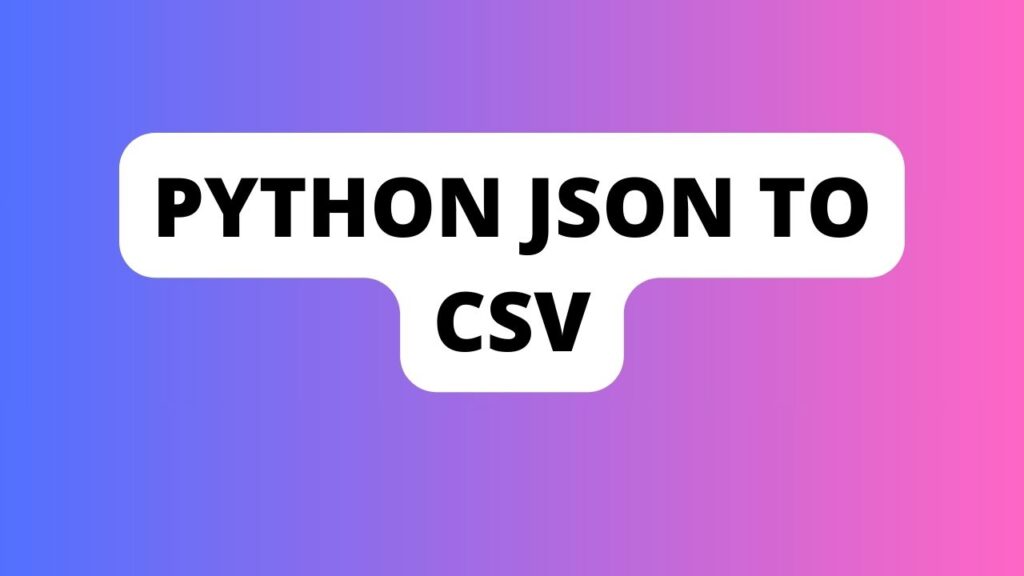Introduction
What is Python JSON to CSV? The journey from JSON to CSV involves transforming structured data from one format to another. In this digital era, efficient data manipulation is pivotal. Understanding the transition from JSON (JavaScript Object Notation) to CSV (Comma-Separated Values) offers unparalleled advantages in data handling and analysis.
Importance of Data Transformation Data is the lifeblood of modern operations. Converting JSON to CSV simplifies data interpretation, enabling streamlined analysis and compatibility across diverse applications.
Understanding JSON
JSON Basics JSON, a human-readable format, organizes and stores data objects in a hierarchical manner. Its simplicity and flexibility make it a preferred choice for data interchange.
Structure of JSON Data A deep dive into JSON’s structure unveils its key elements: objects, arrays, values, and strings. Grasping this structure forms the foundation for effective conversion.
JSON Parsing in Python Python’s innate compatibility with JSON simplifies parsing. Leveraging Python’s libraries facilitates seamless extraction and manipulation of JSON data.
Working with CSV
CSV Introduction CSV, a tabular format, stores data in rows and columns, simplifying storage and accessibility. Its simplicity aids in easy sharing and usage across various platforms.
CSV File Structure Understanding the structure of a CSV file is crucial. Headers and data rows play pivotal roles in comprehending and organizing information.
CSV Libraries in Python Exploring Python libraries tailored for CSV handling expedites the conversion process. Harnessing these libraries automates tasks and ensures accuracy.
Conversion Methods
Converting JSON to CSV Discover multiple methods for converting JSON to CSV, from manual processes to automated scripts, offering flexibility based on project requirements.
Manual Conversion Steps A step-by-step walkthrough of manual conversion aids in understanding the intricacies involved, providing clarity in each transformation stage.
Automated Conversion with Python Python’s prowess in automation simplifies complex conversions. Scripts written in Python automate the process, saving time and reducing errors.
Python Libraries
Pandas for Conversion The Pandas library, a data manipulation powerhouse, offers dedicated functions for seamless JSON to CSV conversion. Its robust features empower efficient data handling.
JSON and CSV Handling in Pandas Delve into Pandas’ capabilities in handling JSON and CSV files. Its functionality streamlines data manipulation, enabling swift conversions.

Best Practices
Data Cleaning and Formatting Practicing data cleaning ensures data accuracy pre-conversion. Formatting data optimizes compatibility and enhances usability.
Handling Nested Data Dealing with nested data structures demands specialized approaches. Techniques for handling nested data streamline the conversion process.
Error Handling in Conversion Understanding potential errors and implementing error-handling mechanisms mitigates risks during conversions, ensuring data integrity.
Advanced Techniques
Streaming Large Data Sets Efficiently handling large datasets involves streaming techniques. Strategies to manage memory and process data in chunks optimize performance.
Optimizing Conversion Speed Enhancing conversion speed involves optimizing code and leveraging multithreading, amplifying efficiency in large-scale transformations.
Use Cases
Real-Life Applications Explore real-world applications where Python JSON to CSV conversions play a pivotal role. From e-commerce to data analytics, discover diverse applications.
Industry Examples Dive into industry-specific examples showcasing the significance of Python JSON to CSV conversions, unveiling their transformative impact.
Benefits
Advantages of Using Python Python’s versatility and simplicity make it an ideal choice for data transformations. Its extensive libraries and community support enhance productivity.
CSV Over Other Formats Highlighting the advantages of CSV over other data formats underscores its simplicity, universality, and ease of use across various platforms.
Challenges
Common Conversion Issues Addressing common challenges encountered during conversion ensures a smoother transition, avoiding potential pitfalls.
Compatibility Concerns Navigating compatibility issues across different systems emphasizes the need for standardized approaches to ensure seamless operations.
Conclusion
Summary of Key Points In conclusion, mastering Python JSON to CSV conversions unlocks a world of possibilities in data manipulation and analysis. Embrace best practices, leverage Python’s capabilities, and explore real-world applications for a seamless transition.
Future of Data Transformation As technology evolves, data transformation methodologies will continue to evolve, promising even more efficient and seamless processes.
FAQs
Q: Is Python JSON to CSV conversion complex? Converting JSON to CSV in Python is simplified with dedicated libraries, offering both manual and automated methods.
Q: How can I handle nested data during conversion? Specialized techniques in Python libraries like Pandas aid in efficiently handling nested data structures.
Q: What are the advantages of CSV over other formats? CSV’s simplicity, universality, and ease of use make it highly preferred for data storage and sharing.
Q: Can Python handle large datasets during conversion? Yes, Python employs streaming techniques and optimization methods for handling large datasets efficiently.
Q: Are there industry-specific applications for this conversion? Absolutely, industries like e-commerce and data analytics extensively rely on Python JSON to CSV conversions.
Q: What should I consider to ensure error-free conversions? Data cleaning, formatting, and error handling are crucial aspects ensuring error-free conversions.
